Small-format decorating is making a big impact in the personalization industry.
Driven by emerging technologies and evolving customer demand, the compact equipment behind it offers flexibility, portability, and new ways to serve customers.

Small But Mighty
Exploring the Growth, Tech Advancements, and Profit Potential Behind Small-Format Decorating
By Michael Clarke
(Originally printed in the May/June 2025 issue of Insights)
Small-format decorating is making a big impact in the personalization industry.
Driven by emerging technologies and evolving customer demand, the compact equipment behind it offers flexibility, portability, and new ways to serve customers.
And while wide-format equipment still dominates for many products, small-format machines offer retailers a way to diversify their services and tap into new revenue streams. These compact machines perform detailed customization through methods such as laser engraving, UV decorating, sandcarving, dye sublimation, and heat transfers—all within a smaller footprint.
Compared to large-format machines, small-format equipment is typically more affordable and better suited to shops with limited space. Their compact size also makes them easy to transport, which opens the door to on-site personalization at events, markets, and pop-ups.
In the shop, these machines can support business growth without major overhead. Because they can often run independently alongside wide-format jobs, they help maximize production time and boost overall efficiency. Their ability to produce one-off or short-run custom products can also mean faster turnaround times for e-commerce and gift orders.
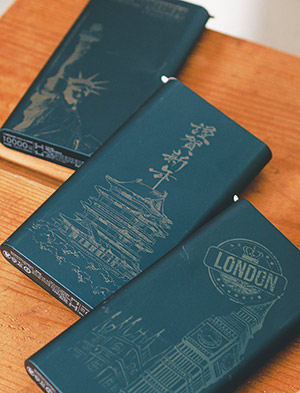
Image Courtesy of FLUX
The Growth of the Small-Format-Decorating Market
The increasing popularity of small-format products has influenced the type of equipment and supplies manufacturers are developing to meet retailer demand. E-commerce platforms like Etsy have fueled interest in customized goods, prompting manufacturers to create more accessible, space-efficient solutions for small businesses with limited staff and production space.
Manufacturers now offer a range of small-format equipment—from compact, entry-level machines to high-speed models for mass production.
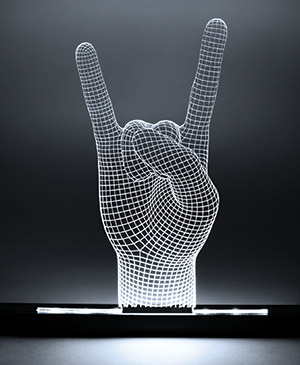
Images courtesy of LogoJET, IKONICS Imaging,
FLUX, Johnson Plastics Plus
Jessica Heldman-Beck, vice president of marketing at Rowmark, says much of this innovation was accelerated by the COVID-19 pandemic, which led to a surge in home-based and side hustle businesses. The shift pushed manufacturers to build more compact machines that fit in smaller workspaces like home offices or garages. Laser engraving has seen significant innovations, specifically.
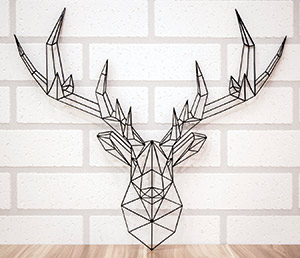
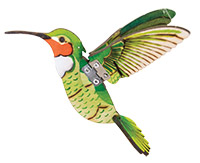
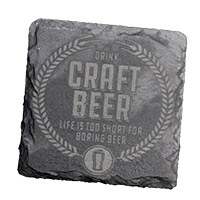
“Increased power, faster processing speeds, and enhanced software compatibility have made lasers more versatile and efficient, catering to a wider range of applications and materials,” she says. She points to the desktop CO₂ laser cutter and engraver FLUX Beambox II, which has a working area of 23.62 inches by 14.76 inches and has expanded capabilities like a chuck rotary attachment, allowing for precise engraving on curved surfaces such as 40-ounce tumblers.
Small-Format-Decorating Technologies and Equipment
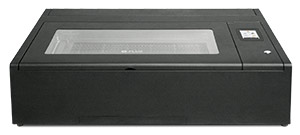 FLUX Beambox II
FLUX Beambox II
Images courestyof FLUX, Epilog Laser,
Johnson Plastics PlusA wide variety of technologies now come in small-format versions, giving personalization businesses new ways to expand their capabilities. Below are some of the more popular technologies.
Laser Engraving and Cutting
Many manufacturers now provide desktop models with work areas of approximately 24 inches by 12 inches. An example of this is Epilog Laser’s Fusion Maker 12. These entry-level machines are still relatively versatile for substrates like wood, acrylic, textiles, and plastic.
And the rotary-engraving category is still popular for several applications, according to Heldman-Beck. For customized signage particularly, this equipment works well for detailed markings on metal and plastics. In fact, the sustained popularity has driven Rowmark to launch a small-format rotary line.
“The consistency and durability of these techniques keep them as staples in the customization market,” says Heldman-Beck.
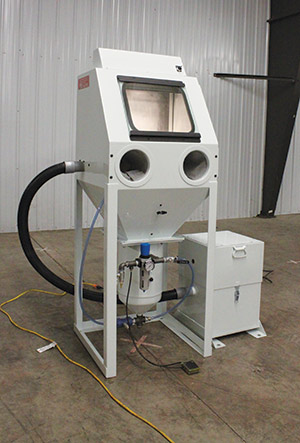 CrystalBlast Pioneer
CrystalBlast Pioneer
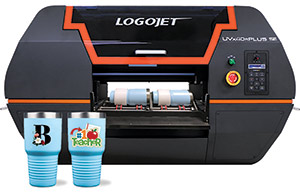 The LogoJET UVx40R PLUS-S machine
The LogoJET UVx40R PLUS-S machineSandcarving
Sandcarving remains a popular method for personalizing glass, stone, and metal—offering a deep, durable, and chemical-resistant finish. Compact systems like the CrystalBlast Pioneer from IKONICS Imaging are designed for small shop environments and for retailers who want to add sandcarving capabilities without the footprint of a full industrial setup. The process works especially well for detailed designs on awards, drinkware, and signage.
UV Printing
UV printers allow users to print direct to substrate on a wide range of goods, including acrylic, canvas, wood, and even small items like golf balls. The ultraviolet light technology cures the ink instantly, making UV printing ideal for retailer customers who want durable, colorfast products like outdoor signs.
Several prominent manufacturers like LogoJET offer small-format UV-LED printers with printable areas from roughly 18 inches by 24 inches up to 24 inches by 36 inches. One example is the LogoJET UVx40R PLUS-SE, which features an 18-inch-by-24-inch printable area.
There’s also been a rising trend of UV direct-to-film printers, which combine UV-LED technology with direct-to-film (DTF) transfer versatility. The transfers can be printed directly onto curved or uneven surfaces.
“The result is a glossy, durable, and scratch-resistant finish that opens up new opportunities for custom-product creation, from branded drinkware and phone cases to signage and home decor,” Heldman-Beck says.
Dye Sublimation
While frequently used for apparel decoration, dye sublimation has also seen a rise in popularity in the small-format-decorating market since it works on various substrates. Hard goods such as tumblers, mugs, coasters, and key chains can be a perfect fit for retailers who work with corporate clients or other customers who need branded swag for employees and end customers.
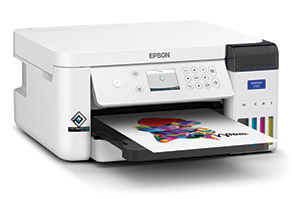
Epson SureColor F170
Dye-sublimation printers are also popular with retailers who have limited production space since some smaller-format printers by companies like Epson and Sawgrass take up a footprint not much larger than a retail-grade inkjet printer. One example is the Epson SureColor F170, which is 14.8 inches by 7.4 inches.
Heat Transfer and DTG
Heat-transfer vinyl is generally reserved for soft goods such as apparel, headwear, and accessories like totes and footwear. But newer technologies of DTF transfers and direct-to-garment (DTG) printing have helped expand this category.
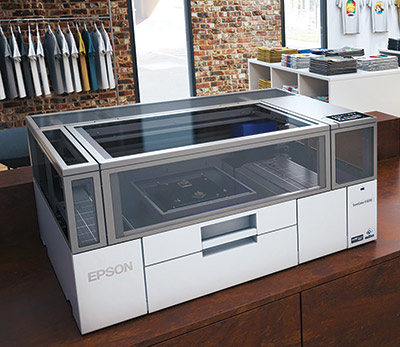
The Epson F1070 dual-purpose printer
“Retailers want equipment that’s versatile and efficient, allowing them to expand their product offerings without needing additional space or capital investment,” says Heldman-Beck.

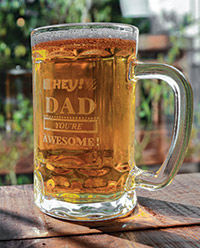 Images courtesy of Desert Pine Designs, FLUX, Johnson Plastics Plus
Images courtesy of Desert Pine Designs, FLUX, Johnson Plastics Plus
She points to dual-purpose machines like the Epson F1070 printer, which offers both DTF and DTG printing capabilities and is relatively compact in size at 35 inches by 17 inches.
Small-format DTF and DTG equipment can be a good option for retailers because it is often slightly more affordable than traditional machines for laser engraving and sandcarving.
Profitable Products and Target Markets
Small-format decorating can help retailers expand further into the personalization market and often attract new business.
Katie Cleveland, the owner of Desert Pine Designs in Peoria, Arizona, does this by bringing her equipment on the road. She takes her xTool F1 laser cutter, paired with the xTool air purifier and a 1,000-watt Jackery portable generator, with her to markets to deliver personalization on the spot.
“It has helped me tremendously at markets and shows to elevate my products with the ability to personalize things for customers,” says Cleveland. Her biggest seller is her wooden travel maps, which include a badge that can be personalized with a name and a quote or anything the customer wants.
“I used to take down the customer’s information and then make and mail all of the badges to them after the markets were over. Now, I’m able to personalize them right there in front of the customers,” she says.
When Cleveland had to make upwards of 50 maps after a show, she realized upgrading to the F1 would help her keep up with the volume and allow her to do so in person.
“It has helped me tremendously at markets and shows to elevate my products with the ability to personalize things for customers,” she says.
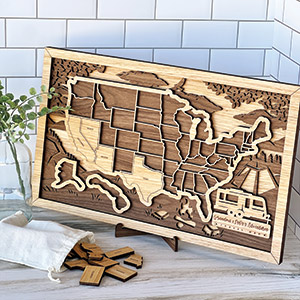 Image courtesy of Desert Pine Designs
Image courtesy of Desert Pine Designs
Outside of events, that same small-format setup works well in Cleveland’s shop, where she personalizes other goods like coasters, pens, and even charcuterie boards.
Combining Small-Format with
Wide-Format Decorating
Introducing small-format decorating might seem like a step backward for retailers primarily focused on wide-format decorating, but the two can work hand in hand to strengthen a business’s bottom line.
“Running smaller jobs while large-format projects are in progress maximizes production efficiency and increases overall profitability,” says Heldman-Beck. “It also reduces downtime and minimizes the chances of turning away potential customers.”
Using both formats also means retailers have more variety when offering customers a bundled package. Decals, pens, shirts, and lawn signs are just a few examples of items that pair well with wide-format banners and signage for clients looking for a complete branding solution.
With manufacturers continuing to develop entry-level laser engravers, UV printers, DTF machines, and more, the barrier to entry for small-format decorating remains relatively low. Whether used on its own or to complement wide-format services, small-format decorating enables retailers to offer unique, high-margin products that appeal to a diverse customer base
SIDEBAR 1:
What You Can Make with Small-Format Decorating—and Who Wants It
Small-format equipment can be used to customize a wide array of products. Below is a look at popular personalized goods and the customer markets they tend to serve best.

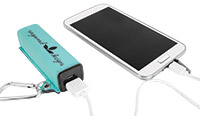 Images courtesy of JDS, Desert Pine Designs
Images courtesy of JDS, Desert Pine Designs
Custom drinkware (mugs, tumblers, bottles): Personalized drinkware works well for corporate clients and individual customers. Whether for a customer’s special occasion like a wedding or family reunion or a corporate client’s branding campaign, it can be part of a larger order or offered as a stand-alone product for retailers.
Cleveland suggests that drinkware items like engraved tumblers will always be a popular choice.“It is a very easy way for businesses to advertise, gift employees, or [reward] valuable clients with a tumbler with their company logo engraved on it,” she says.
Awards and plaques: These remain a core offering for many personalization businesses, especially for customers in the corporate, education, and nonprofit sectors. Awards and plaques are commonly used for employee recognition, sports teams, donor appreciation, and academic achievements.
Branded promotional items (pens, USB drives, key chains): Like drinkware, these products are compatible with a wide range of customization methods. They also work well as part of a bundled order, helping retailers boost profitability by grouping multiple personalized items for events or corporate gifting. These products are especially popular for trade shows, conferences, and other large-scale events.
Home decor (wood signs, acrylic nameplates): Home-decor items appeal to individual customers and business clients. These products work well in industries like real estate—where agents may want to personalize model homes or offices—as well as for small businesses and boutiques aiming to create a distinctive branded environment.
Custom apparel (hats, T-shirts, bags): Decorated apparel is a promotional cornerstone for nearly every market, be it franchises, manufacturing companies, corporations, or small businesses. Event organizers, sports teams, and educational institutions also represent significant markets for custom apparel, especially for commemorative events or team branding. Plus, pairing decorated apparel with trophies, plaques, and medals is great for everything from seasonal sports to scholastic achievements and clubs.
SIDEBAR 2:
Popular Applications for Small-Format Decorating
Small-format printing is most profitable when retailers use it to tap into the right market or niche. Heldman-Beck shares a few ideal applications for this technology.
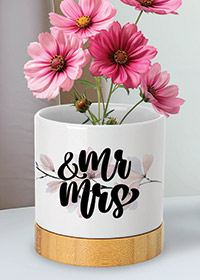
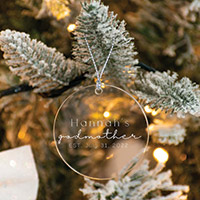 Images courtesy of Johnson Plastics Plus,
Images courtesy of Johnson Plastics Plus,
three Sixteen Studio
Weddings and special events: This industry is a consistent driver for small-format printing. Retailers can print custom signage, table numbers, party favors, and even personalized gifts like engraved glassware and coasters. “The ability to print on demand allows for last-minute adjustments and one-of-a-kind details that enhance the overall experience,” Heldman-Beck says.
Home decor: Small-format decorators can create personalized items such as throw pillows, wall art, photo panels, and drinkware.
Live events and workshops: Live printing at events gives retailers a unique way to connect with customers and generate additional income. Heldman-Beck suggests allowing customers to personalize products on the spot to further that memorable experience and ideally build repeat business.
Craft fairs and farmers markets: These kinds of events give retailers a chance to showcase small-format goods like mugs, ornaments, or water bottles and help attract more foot traffic.
Holiday customization: A peak time for all customization categories, holiday small-format printing is the perfect way for retailers to capitalize on the demand for personalized gifts like ornaments, stockings, apparel, and drinkware. “The ability to quickly produce high-quality, one-off items gives small-format printers a competitive edge during this busy season,” says Heldman-Beck.
Michael Clark is the content marketing manager for Inktavo, a
family of software solutions that help print shops, promotional
product distributors, and branded merchandise businesses
succeed. Over the past decade, he’s also contributed as an editor
and columnist to several publications in the decorated apparel,
promotional products, and signage industries.
